
Pet owners know how difficult it is to let go of their beloved pets. It is no easier to make the decision if the pet’s owner is a veterinarian.
What happens when the veterinarian is on the other side of making a euthanasia decision for her dog?
Last fall, Dr. Michelle McDonough and her family faced the challenge many pet owners experience, when their 12-year-old dog reached the end of her days. For about six months, Lola showed signs of slowing down. “She went from being a puppy her whole life to… not,” said McDonough.
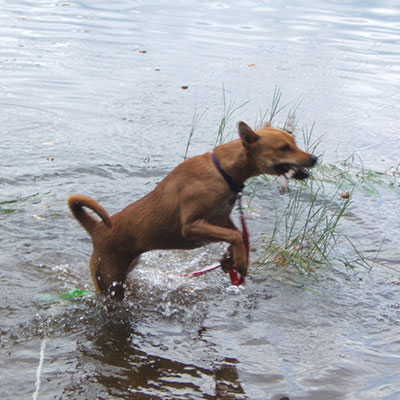
Rescue pup Lola abounds with joy on her first experience up north with her new family.
“It started with the common behavior changes.” Lola struggled to get in and out of the car. She sometimes slipped and splayed on the floor for no apparent reason, except maybe she was trying to pick up a little speed to get to the door. She had accidents that seemed beyond her control.
“We were seeing her not wanting to go on walks. She didn’t want to play ball. She wasn’t eating well. She didn’t have an interest in or the ability to crawl into bed with us. We knew it was coming,” said McDonough. “She just aged so quickly.”
McDonough and her husband Nick adopted Lola when she was little more than a year old. They did not yet have children, and they spent a lot of time finding the perfect dog for their little family of two that they ultimately planned to expand. They decided they wanted a medium-size dog who was potty trained and seemed to have a good disposition. They also wanted their dog to be a rescue.
After much time on petfinder.com and visits to shelters, they visited a foster family with a red pup who wiggled and radiated sheer joy. Her huge brown eyes were captivating. “And we fell in love,” said McDonough.
Three years later, the McDonoughs brought their son into the family, and two years after that, their daughter was born. “Lola was absolutely a member of our family,” said McDonough, noting she wasn’t especially interested in babies that didn’t seem to do much, but that changed as the children grew. They became more interesting to Lola, who discovered short people made pretty good playmates.
The children also took responsibility for Lola in the last two-plus years of her life. They helped care for her, played with her and loved on her. Theirs was a family wholly invested in providing care and love for their beloved dog.
“I think I started grieving six months before she died,” said McDonough. “That was the hard part. Nothing that was happening to her was quick. It was all very gradual.” Part of her grieving process while Lola was still alive, but the outcome seemed inevitable, was needing to just talk about her. “I wanted to talk about it with friends, the other doctors at work, my husband. I wanted to talk about her quality of life and wrap my head around it.”
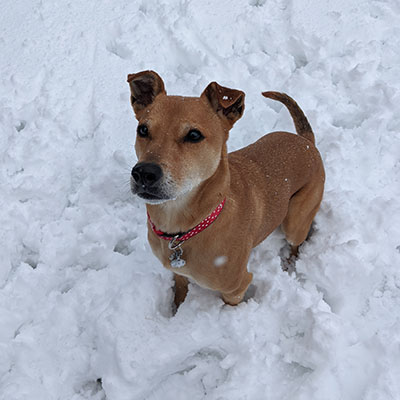
The white stuff is a bit chilly, but overall it is rather amusing.
As October drew to its end, McDonough took Lola to the clinic for some tests. It hadn’t been that long since she had bloodwork and an ultrasound, but because the changes were becoming pronounced, it was time for retesting. “She had always had normal blood, urine, etc.,” said McDonough, “but that day she didn’t. Her bloodwork showed elevated liver values. The ultrasound told the story.” Lola had a mass on her adrenal gland and another on her liver.
“These weren’t things we were going to be able to fix,” said McDonough. She had congestion as well, so with that, her age and the location and nature of the tumor, anesthesia was out of the question.
The next step was telling her husband. “I had to talk to Nick, but it was so hard because it was like being the vet giving bad news to the owner, yet I was the owner too. It was interesting to see how difficult making the decision was when I was the one on the other side. You think you should know when their time has come. Everybody always tells you you’ll know when it’s time,” said McDonough, “but you don’t.”
“The experience made me realize it’s harder than I thought it would be.” The decision a family makes should be based on the pet’s quality of life. “Think about what they do. Do they still like to do those things?” Greendale Village Vet has a tool that helps owners who struggle with their decision. It’s a product called the Lap-of-love-quality-of-life scale, and some owners find it helpful in clarifying how well their pets are doing relative to their conditions.
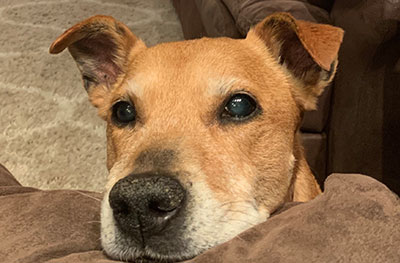
“If I look really, really cute, I bet I’ll get a potato chip…”
“I was in turmoil,” said McDonough, and I talked to my colleague Dr. Kathy Passinault.
“It should be a difficult decision,” Passinault told her.
“It was reassuring to know everyone has doubts,” said McDonough. The next steps, though, were making the decision and making a plan. She and her husband decided they would take Lola for her final rest a week after the test results had been confirmed. That would give them time to prepare their children as well as themselves.
“We wanted to be honest with the kids,” she said. “We wanted to tell them exactly what was happening. But it was very hard to explain making a decision like that, because the children are so young. The only immediate question they had was what would happen to Lola after she died. We told them she would go to heaven, and that satisfied them.”
The McDonoughs cancelled outings and events to focus entirely on Lola for her last weekend. They wanted only to spoil her, love on her and celebrate her. Most of the euthanasia cases the clinic sees are scheduled ahead of time, she said. “I think it’s beautiful when you can prepare for it,” she said. “You have those final moments to play with a favorite toy, give treats, walk or prepare special meals.”
“It was very special to have that time we had with her,” said McDonough. “All of us, and our extended family members, had a chance for their own goodbyes. She sat on the furniture; we took lots of pictures. We all chose the things we wanted to do with her. She had a steak dinner and ice cream. At the end, we did not need to say ‘I wish I would have.’”
McDonough said timing the appointment had been tough because of the balance between not wanting Lola to suffer and not wanting her to leave. “Dr. Passinault had words that really helped. She said, ‘If it’s obvious, you’ve probably waited too long.’ In other words, waiting until they’re really, really sick means they’ve suffered.”
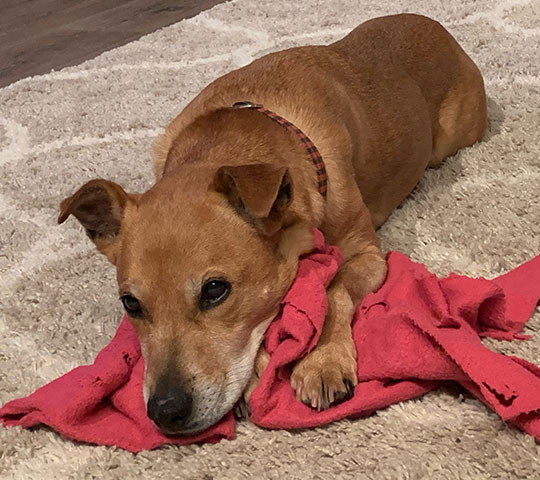
Lola acted like a puppy her whole life, but during the last six months of her life her energy waned.
People have often told McDonough they imagined the worst part of her job as a veterinarian is euthanizing pets. “It really isn’t,” she said. “It’s a special gift to be able to end their suffering.” That was on her mind when she, Nick, Lola and Dr. Passinault had Lola’s last appointment.
People handle that differently, she said. “Most owners want to be there for the final moments, but some people can’t bear it. It’s OK not to be there, and owners should not feel guilty about that. Our staff is very caring, and they are there to comfort the pets in their last moments.” The McDonoughs opted not to have their children be part of the process, but she said sometimes the whole family is there. “People need to make the decisions that are best for them. There is not a right or wrong way to go through this process.”
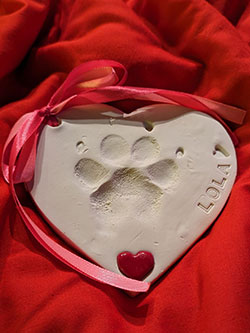
Greendale Village Vet offers clay paw prints to families after their pets have died.
One of the staff members put an intravenous catheter in Lola’s foreleg to be able to access her vein. McDonough said sometimes they sedate the pets so they’re sleepy before the euthanasia drugs are injected. As is the practice at Greendale Village Vet, the McDonoughs had as much time as they needed before Passinault administered the final dose.
“Then, when Lola passed, Dr. Passinault left us to be alone with Lola for our final, private goodbyes,” said McDonough. It was a peaceful experience, and despite their deep grief, they knew their choice was the final act of love and kindness for the dog who had enriched their lives for so long.
Greendale Village Vet offers cremation services that include having the ashes returned to the family if it wants them. The clinic also provides clay paw prints or hair clippings for families who want those. The clinic is highly regarded among its clients for the compassionate and professional manner in which the entire staff provides euthanasia service.
For more information or to schedule an appointment, call 414-421-1800 or visit https://greendalevillagevet.com/


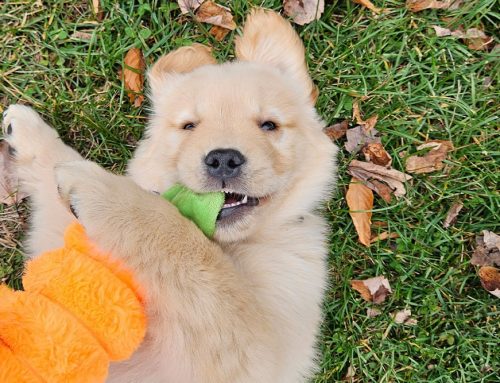

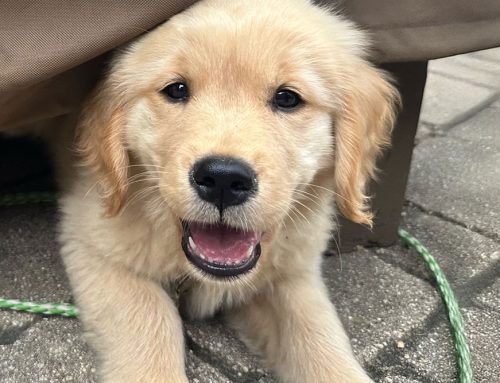
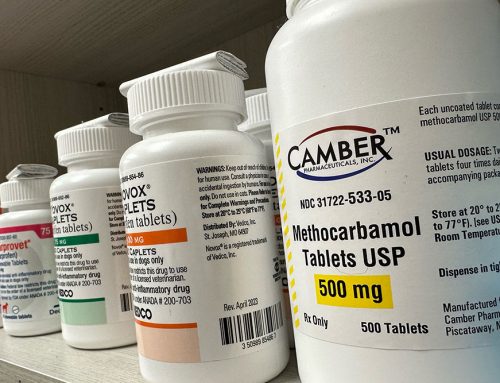
Leave A Comment